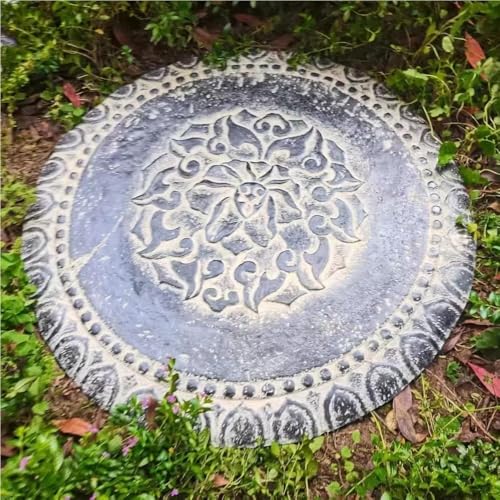Septic tanks — they’re a necessity, but not exactly the gem of your yard’s aesthetic. If you’ve been wracking your brain on how to cover up that unsightly septic tank without causing damage or hindering access, you’re in luck! We’ve got some creative and practical landscaping ideas to help beautify your space while keeping your septic system fully functional.

Now, let’s get something straight right off the bat. When it comes to dressing up that septic tank area, safety and accessibility should be your top priorities. You want to ensure whatever solution you choose doesn’t impede regular maintenance or risk damaging any part of the system.
But don’t worry – with careful planning and a little creativity, you can transform that once drab spot into an attractive feature of your landscape! Read on for our favorite tips and tricks on turning a necessary eyesore into an eye-catching spectacle.
Understanding Your Septic Tank Landscape
So, you’ve got a septic tank. It’s an essential part of your home’s waste management system, but let’s be honest – it’s not the most eye-catching feature of your yard. Don’t fret! With some clever landscaping ideas, you can turn that unsightly necessity into a beautiful part of your garden.
First off, knowing where your septic tank and drain field are located is crucial. You’ll need this info for planning out your landscaping project. Remember not to place anything heavy over these areas as it could damage the system and lead to costly repairs.
Next up – plants! They’re your best friend when you’re trying to hide that septic tank cover. But bear in mind, not all plants are suitable for this task. Choose plants with shallow roots like perennials or grasses that won’t interfere with the system below ground level.
What else can work? Hardscaping features such as decorative rocks or statues can also help mask the area while adding interest to your yard. Another idea is creating raised beds around the tank area – just make sure they’re built heavy enough so they don’t shift and disturb any underground pipes!
Lastly – maintenance matters! Whichever solution you go for, ensure it allows easy access for routine pump-outs and inspections. After all, looking good doesn’t mean much if functionality is compromised.
And there we have it! With a bit of creativity and careful planning, even something as mundane as a septic tank can become an attractive part of your overall landscape design.
Assessing the Best Landscaping Ideas for Septic Tanks
Let’s face it, septic tanks aren’t exactly a garden’s best friend. They’re necessary, but they can be quite an eyesore if left exposed. But worry not! With some clever landscaping ideas, you can make that septic tank practically disappear.
One of your top options? Plantings. Soften that hard look with garden planters and low-lying shrubs. Just remember to keep them shallow-rooted so as not to interfere with the system. Here are some examples of plants perfect for this:
- Creeping Thyme
- Sedum
- Lavender
Grasses too could work their magic in no time at all! Tall ornamental grasses like Pampas or Feather Reed Grass could conceal your septic tank while adding movement and texture to your landscape.
If you’re into more structural options, decorative covers might tickle your fancy. These come in various designs – from faux rocks to sculptures, there’s likely a cover that matches your yard aesthetic.
Another great idea is using hardscaping elements like fences and trellises. They don’t just cover up; they also add value to your property by creating defined spaces within your landscape.
So there you have it – some of the best landscaping ideas for those pesky septic tanks! Remember: It’s about integrating them into the design rather than trying to hide them away completely. Incorporating these tips should help transform what was once an eyesore into something that enhances the aesthetics of your outdoor space.
Combining Function and Aesthetics: Covering Septic Tanks
Your backyard’s not just a place for the kids to play or for you to grow some tomatoes. It’s also home to your septic tank – an essential, yet unattractive feature of many homes. But hold on! There are ways you can hide that old septic tank without compromising its functionality.
One clever way is by using plants. Not any plant will do though! It’s best to stick with shallow-rooted ones like perennial ryegrass or clover. They help camouflage the area while making sure nothing disrupts your system below ground level.
Here are some examples of suitable plants:
- Perennial Ryegrass
- Clover
- Marigold
- Zinnia
Another great solution? Decorative covers. You’ve got a bunch of options here, from artificial rocks and wooden boxes, even upcycled items like old bathtubs or canoes can work wonders when done right.
« Cheap Low Maintenance Landscaping Ideas: Beautify Your Yard on a Budget Driveway Border Landscaping Ideas: Your Guide to a Stunning Entrance »
Now, if you’re feeling really creative, try landscaping around it with a garden bed or a gravel path leading away from the area. This draws the eye away from your septic tank cover and adds an aesthetically pleasing element to your yard.
Let me tell you about Joe – he was tired of his unsightly septic cover ruining his perfect view every time he looked out his kitchen window. So what’d he do? He built himself a wishing well right over it! Now instead of an eyesore, he has a charming feature that sparks conversation at every backyard gathering.
So remember folks, covering up that septic tank doesn’t have to be dull work. With a bit of creativity and planning, you can combine function with aesthetics for something truly unique in your yard.
Choosing the Right Plants to Mask a Septic Tank
Let’s dive in and talk about plants, specifically those perfect for masking your septic tank. First off, you’ll want to select shallow-rooted flora. Why? You might ask. Well, deep roots can potentially damage your septic system over time by growing into it. So, going for plants like perennials and annuals is a smart move as their root systems are typically shallower than most.
Now here’s something you’ve probably not considered – Native plants! They’re accustomed to your local climate and soil conditions which means they’ll likely thrive without much fuss. Think of them as low-maintenance friends who do their job without demanding too much from you.
A couple of favorites among homeowners include:
- Ornamental grasses like Blue Fescue or Fountain Grass
- Ground cover options such as Creeping Thyme and Stonecrop Sedum
- Perennials like Coneflower or Daylily
You see, these plants don’t just help hide that unsightly septic tank but also add beauty to your landscape design!
But hang on a tick! Don’t go planting trees or large shrubs directly over the drain field of your septic system. Their aggressive root structures can cause serious damage over time.
And lastly, remember that while we’re talking about beautifying the space above your septic tank with greenery, it still needs access for maintenance and inspections – so don’t forget to leave room for technicians when selecting and arranging those charming little plants!
In short: Choose wisely considering both aesthetics AND functionality when picking out foliage to mask that pesky septic tank in your yard.
Hardscape Options for Hiding Your Septic System
So, you’ve got a septic system that’s doing its job great but it’s not exactly a feast for the eyes? Don’t worry, we’ve all been there. Thankfully, hardscaping can come to the rescue here. It offers several clever ways to disguise those unsightly septic tanks without compromising their functionality. Let’s take a look at some of these innovative solutions.
Rock gardens are your new best friends! They’re not just pleasing on the eye but also provide an excellent camouflage for your septic system. You can pile up rocks and stones around the tank area in an artful manner that mimics natural landscapes. To top it off, adding succulents or other drought-resistant plants will give it a more organic feel while keeping maintenance low.
Another smart idea is to use decorative fences or screens. Now you might be thinking, “Won’t this draw attention?” Well, with some creativity and strategic positioning, you can make these structures blend seamlessly into your yard while hiding away your septic tank.
If you’re into DIY projects then consider building a raised garden bed atop your drain field (that part of your yard where water from the septic tank flows). Remember though – only shallow-rooted plants should be used here as deep roots could damage the pipes underneath.
Paving slabs or stepping stones can also work wonders if laid out strategically over the drain field area; they’ll help distribute weight evenly thus protecting those precious pipes below while giving visitors a charming pathway to tread upon.
Lastly, why not think about installing something fun like a bird bath or small fountain near your tank cover? They’ll serve as focal points pulling eyes away from what lies beneath!
Remember folks: dealing with an exposed septic system doesn’t mean sacrificing aesthetics. With these hardscape ideas in hand, you’re well equipped to beautify your outdoor space while keeping that essential system hidden.
Incorporating Outdoor Art to Conceal a Septic Tank
So, you’ve got a septic tank in your backyard and it’s not exactly the most appealing sight, right? Don’t sweat it! One of the best ways to hide that eyesore is by incorporating outdoor art into your landscaping.
Now, before you start thinking about giant sculptures or intricate murals, let me assure you there are simpler (and cheaper) ways to do this. You could consider installing a decorative panel or trellis around the tank area. It’s not only budget-friendly but also adds an artistic flair to your garden. Plus, climbing plants like ivy or clematis would love to make it their home!
If you’re feeling adventurous, how about creating a rock garden? This low-maintenance option can actually turn out pretty cool with some strategic planning. Start by arranging large rocks around the tank and gradually add smaller ones for variation. Why not throw in some succulents and moss too? They’re perfect for that rugged look.
Perhaps you prefer something more rustic? Then an old-fashioned wishing well might just be what you need! It serves as a fantastic focal point while conveniently hiding your septic tank underneath. Just remember: no actual water involved!
Lastly – if none of these ideas tickle your fancy – there’s always custom-made solutions available. You could have covers designed that blend seamlessly with the rest of your landscape, from faux boulders to replicas of lawn ornaments.
Remember, creativity is key here. With some imagination and effort, even something as mundane as a septic tank can become part of your outdoor masterpiece!
Case Studies: Successful Landscaping Over Septic Tanks
Who said dealing with a septic tank has to be an eyesore? Let’s dive into some real-life examples of homeowners who’ve brilliantly camouflaged their septic tanks without compromising the system’s functionality. You’ll see that it’s entirely possible to turn a necessity into something quite pleasing to the eye!
First off, let’s take you to sunny California where one homeowner turned his unsightly septic tank lid into a stunning rock garden. He used artificial rocks made from fiberglass and resin, which are not only lightweight but can be easily removed for maintenance. To add more charm, he placed small succulents and drought-tolerant plants around the rocks.
In another corner of America, in rural Virginia, a family got creative with their green thumbs! They planted perennials like hostas and daylilies around their septic drain field. These plants have shallow roots which won’t interfere with the system while providing ample coverage over time.
Ever thought about incorporating your septic tank into your patio design? Well, you’re not alone! A couple in Colorado did exactly that by creating an elevated wooden deck around their above-ground tank. It served as a clever disguise and added valuable outdoor living space.
- California case: Rock garden using artificial rocks
- Virginia case: Planting perennials like hostas and daylilies
- Colorado case: Building an elevated wooden deck
Each of these homeowners found unique ways to incorporate landscaping techniques that are safe for their septic systems while adding beauty to their yards. So yes, it may take a little imagination and planning, but don’t let that hinder you from transforming what could be perceived as an inconvenience into an appealing feature of your property!
Conclusion: Perfecting Your Septic Tank Landscape
Alright, you’ve made it to the end of the journey! By now, your backyard should be boasting a whole new look that masterfully hides your septic tank. Let’s do a quick recap, shall we?
First off, don’t forget about those natural elements like rocks and boulders. They’re not just useful for their camouflage abilities – they can also add a rustic charm to your yard.
Next up were plants. Remember how we chatted about using native species? That’s because they’re more likely to thrive in your local climate and soil type. Plus, they often require less maintenance than exotic alternatives.
Oh, and let’s not forget the importance of strategic placement! You’ve learned that mapping out where each element will go before digging can save you loads of time (and potential re-dos).
Finally, remember how we talked about accessorizing with outdoor décor? It’s all about creating focal points away from the septic tank area. Think bird feeders, fairy gardens or an exquisite statue!
Now here are some final tips:
- Always keep septic system safety in mind
- Don’t plant deep-rooted trees near the septic tank
- Regularly check on your landscape to ensure it’s doing its job
With these tidbits under your belt and some creativity at hand, there’s no doubt you’ll perfect that septic tank landscape in no time. And remember – landscaping is an art form that takes practice. So don’t worry if things aren’t perfect right away.
That’s it folks! Hopefully this guide has given you plenty of inspiration for landscaping around your septic tank while keeping functionality intact. Who said practicality couldn’t be pretty?
















